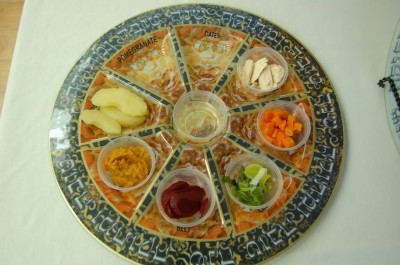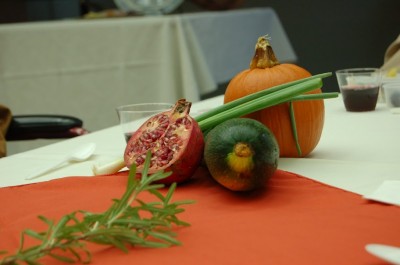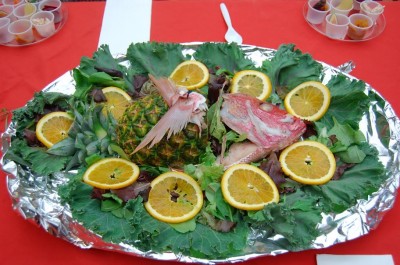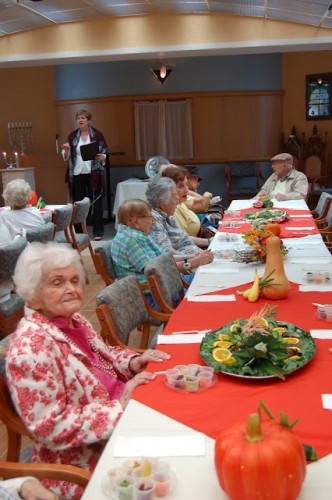The Rosh HaShanah Seder
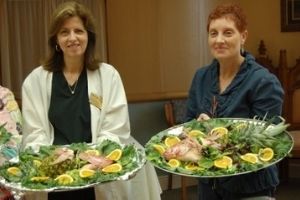
By Rabbi Barbara Aiello
 After the Chosen Food exhibition opened almost a year ago, my research on Jewish food slowed considerably, but it did not come to a complete halt. I’m forever hearing about something that is new to me, or seizing on bits of history and culture that I put aside for further investigation. The Sephardic/Mizrachi custom of the Rosh HaShanah seder was included in our exhibition, thanks to Poopa Dweck’s generosity in sharing a photograph from her beautiful cookbook, Aromas of Aleppo (Harper Collins, 2007), but we didn’t explore it in depth. So I reached out to Rabbi Barbara Aiello, a woman on the forefront of popularizing this lovely custom in America, to write about her experiences for us.
After the Chosen Food exhibition opened almost a year ago, my research on Jewish food slowed considerably, but it did not come to a complete halt. I’m forever hearing about something that is new to me, or seizing on bits of history and culture that I put aside for further investigation. The Sephardic/Mizrachi custom of the Rosh HaShanah seder was included in our exhibition, thanks to Poopa Dweck’s generosity in sharing a photograph from her beautiful cookbook, Aromas of Aleppo (Harper Collins, 2007), but we didn’t explore it in depth. So I reached out to Rabbi Barbara Aiello, a woman on the forefront of popularizing this lovely custom in America, to write about her experiences for us.
Rabbi Barbara, as she likes to be addressed, is the first woman rabbi and first non-orthodox rabbi in Italy. She serves Sinagoga Ner Tamid del Sud, the first active synagogue in Calabria since Inquisition times. During the winter months she serves the Kobernick senior living campus in Sarasota, Florida where she is resident rabbi. Contact her at www.rabbibarbara.com.
For more information about how to celebrate a Rosh HaShanah seder, complete with a “mini haggadah,” go to Rabbi Barbara’s 2010 post on Interfaith Family at http:///www.interfaithfamily.com/holidays/rosh_hashanah_and_yom_kippur/The_Rosh_Hashanah_Seder_Who_Knew.shtml
Shana tova umetukah!
Karen
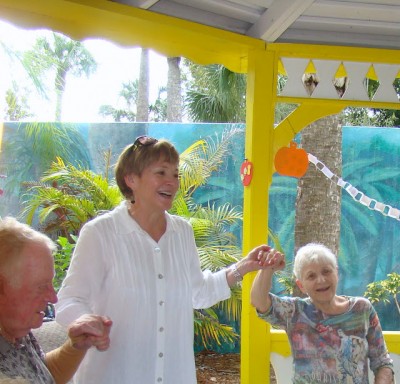
All of us know the most popular seder of all – the Passover Seder. “Seder” is a Hebrew word that means “order,” and the Passover seder includes an order of prayers and blessings, symbolic foods and songs, and of course, a special seder plate, to help tell the story of the our Jewish ancestors’ flight from slavery in Egypt to freedom.
The less well-known Rosh HaShanah seder is a Sephardic custom. In Jewish homes in Italy, Spain, Portugal, Turkey, Greece, North African countries like Morocco and Egypt, and India, it is traditional for families to hold a seder on the night before Rosh HaShanah.
The Rosh HaShanah seder is similar to the Passover seder in many ways. It includes stories, prayers, blessings, songs and symbolic foods. In recent years seder plates designed especially for the symbolic Rosh HaShanah seder foods have become available so that families can create a specific “order” to celebrate the birthday of the world.
The Rosh HaShanah seder is called “Seder Yehi Ratzon,” the Seder of God’s will, because we offer blessings that it will be God’s will that we are blessed with bounty, strength, and peace in the coming year. The seder has its origins in the Talmud (Horayot 12a) where Rabbi Abaye writes about eating those foods that grow in abundance at this time of the year. We serve this abundance at our Rosh HaShanah seder table as a symbol of prosperity.
As a Sephardic Jew and rabbi who serves a congregation in Calabria, Italy, for part of the year, I brought the Rosh HaShanah seder to my congregants who live at the Kobernick senior community in Sarasota, Florida. I’ve offered the seder tasting for three years to participants who range in age from 70 to over 100 years old, and members of the community who volunteer on our campus. We create small seder plates so that each individual can sample the symbolic foods. A larger plate contains a taste of the symbolic foods such as dates or pomegranates, figs, apples and honey, carrots, pumpkin or squash, beets, scallions or leeks and tuna fish. The table centerpiece features a large fish head, reminiscent of the ancient seder tradition where a large steamed fish was offered as the main course.
The Rosh HaShanah seder is quickly becoming an important event in the celebration of the Jewish New Year, mainly because it offers a joyful simcha during a solemn time of the year. Sometimes the birthday of the world is secondary to Rosh HaShanah’s more somber message of teshuvah (return). The Rosh HaShanah seder offers a moment of joy prior to the services that contain a more serious theme.
The cultural element to the seder experience gives American Jews, the majority of whom have roots in the Ashkenazi tradition, a chance to experience a simcha that originates from Sephardic or Middle Eastern culture. Because we Sephardic Jews are a minority within a minority, our unique culture is often obscure or misunderstood. The seder gives Jews of all backgrounds a glimpse into the beauty of the Mediterranean Jewish culture, broadening the “meshpucha” feeling for all of us.
Finally those who participate in the Rosh HaShanah seder have the opportunity to add another family-based observance to the New Year experience. We Jews enjoy gathering around the family table. The Rosh HaShanah seder is another way to bring the family together, not only to tickle the palate, but to share in gratitude for another year of love and life.

